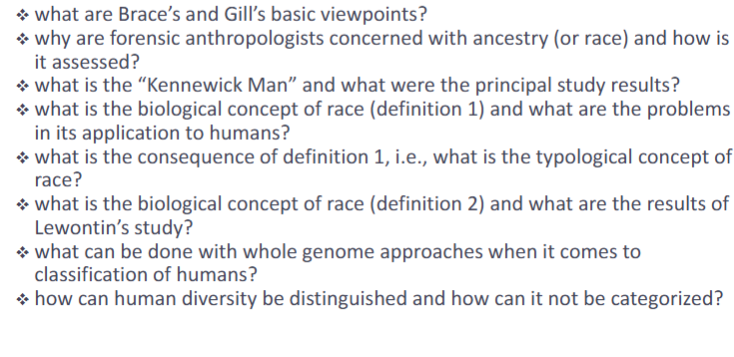ANP 220 do human races exist_16
1/25
There's no tags or description
Looks like no tags are added yet.
Name | Mastery | Learn | Test | Matching | Spaced |
|---|
No study sessions yet.
26 Terms
different perspectives: c. loring brace
no evidence for race
can assess geographic region but not coherent entities(in contrast to laypersons belief)
variation is clinal and patterns differ
should use geographic labels
concept is cultural and political
racial terms are linked to capabilities
use favors racism
different perspectives: george w. gill
useful concept
can assess geographic, racial affinities w/ high accuracy (particularly if multple skeletal markers are used
depedns on traits (not w/ blood groups)
“reality of race” depends on definition of reality
divide clines into categories (as for age)
racial denial politically motivated (correctness)
denial favors racism
forensic anthropology is
the formulation of a biological profile of otherwise unrecognizable human remains for legal purposes
used for work in
criminal cases
fatalities
biological profile: ancestry
based on morphological variations (bones)
multiple measurements; analyzed statistically
output: possible ancestry and error probability
describes the origin of a person
bio-geographic region
fairly correct
applies to skeletal (bone) measures
NOT to visual assessments like skin etc
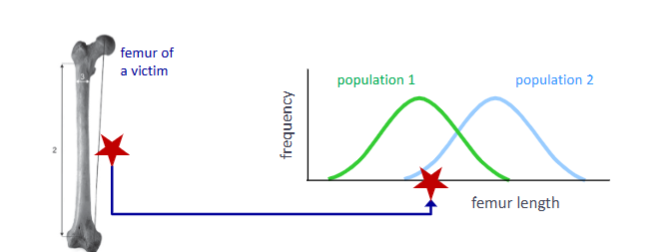
Keenewick Man
found 1996
claimed by 5 tribes
lost appeal in 2004
study results
8-9,000 yrs B.P.
morphologically
Caucasian male
genetically
Southeast-Asian-Ainu
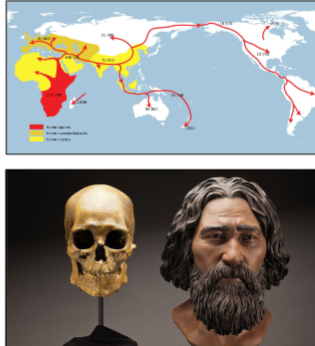
what is race?
the division of humankind into groups of people based on combination of various, conspicuous biological characteristics such as for example skin color facial form, eye shape etcthe division of human kind into groups of people based on common decent and genetic similarity
what is race (biologically) definition 1
intraspecific category characterized by conspicuous physiological, biological, geographical or ecological traits
much of human biological variation
discordant
clinally distributed
different patterns incongruent
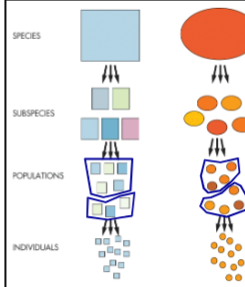
typological concept of what is race
people of different origin
consistently different; must be distinguishable
each group is represented by one distinct “average type”
individuals within race similar; little variation
human and trait variation
typological concept
distinct categories
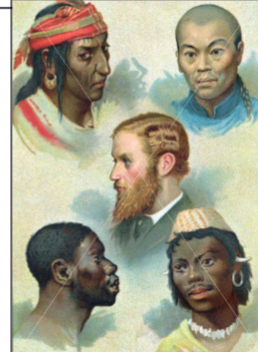
variation concordant
all traits are shared within a population
variation discordant
not all traits are shared within a population
the more traits we use the more categories (races) we get
humans and discordant traits
typological concept
distinct categories
BUT variation is
discordant
categories (“races”) depend on traits
humans and clines
typological concept
distinct categories
BUT many human traits
clinally distributed
NO distinct categories
do arbitrary categories work?
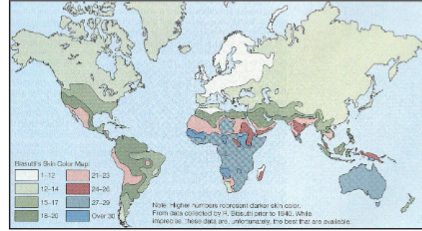
generally distribution of skin color: 3 categories

geographical distribution of O blood type: 3 categories
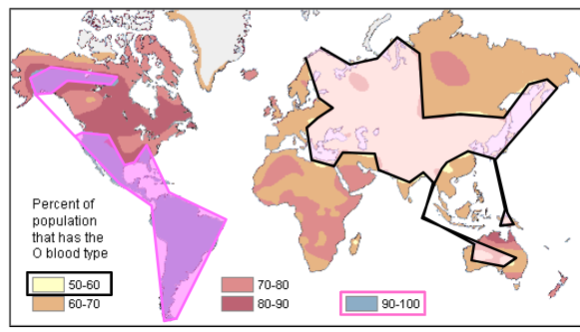
frequency of lactose intolerance: 2 categories
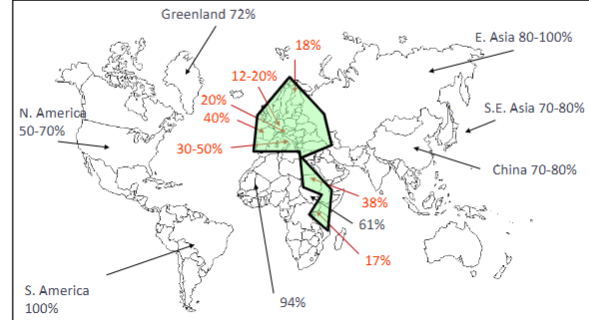
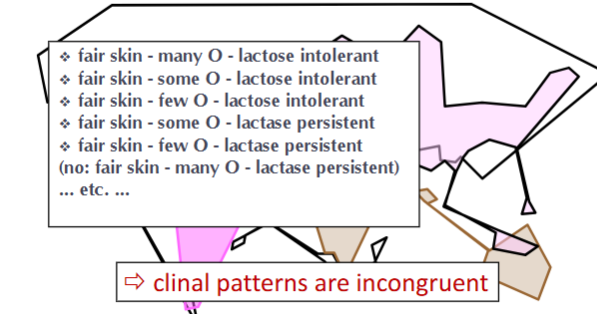
skin color, O allele, and lactose intolerance
→ clinal patterns are incongruent
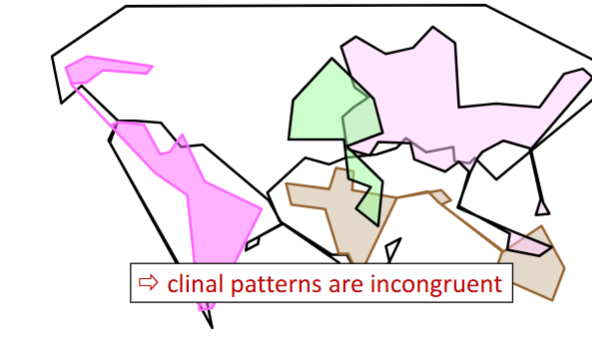
what is race (biologically) definition 2
interbreeding, usually geographically isolatedpopulation differingfrom other populations of the same species in the frequency ofhereditary traits (20-30%) difference
genetic variation in humans
richard lewontin (1972)
17 polymorphic genes (blood groups)
measured heterozygosity
1 allele = 0 (no diversity at that locus)
many alleles = high diversity
many and no rare alleles = highest diversity
how much diversity is accounted for
within each population
total diversity between individuals
within each “race”
total diversity between populations
between “races”
total diversity between races
7 conventional races
caucasians
arabs, armenians, austrians, basques, belgians, indians(hindi-speaking), pakistani(urdu-speaking), russians, welsh etc
Amerinds
aleuts, apache, “brazillian indians”, chippewa, maya, yanomama
black africans
mongolians
south asian aborigines
oceanians
australian aborigines
genetic variations in humans: percentages
within populations
85.4% of variation
within belgians
within races
8.3% of varition
between arabs and belgians
between races
6.3% variation
between caucasions and africans
result
variation within populations >> within races >_ between races
less than 10% between races
genetic variation in humans: expectation(from def 2) and observed
expected: most variation between races
findings: most variation within population
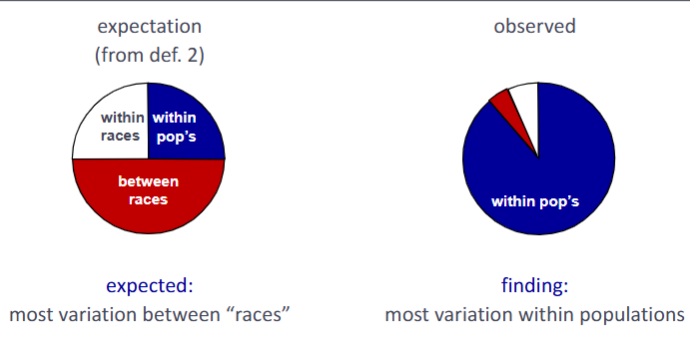
genetic diversity in europe
can distinguish between populations (with error and overlap)
can be applied to karger geographic areas (with error)
would have to define as many races as populations
still no distinct categories

human biological diversity
cannot be categorized into distinct groups reliably using
conspicuous markers (such as skin color)
certain physiological and genetic markers (such as blood groups)
→ the biological race concept using racial types is useless
can be distinguishing more or less reliably using
many morphological (bone) measurements simultaneously
errors and overlap do occur
whole genome approaches
errors and overlap occur
→ is this race as we usually define or use it - depends on markers
learning objectives
